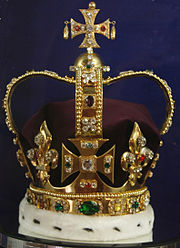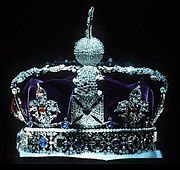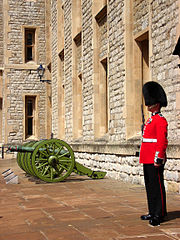
Crown Jewels of the United Kingdom
About this schools Wikipedia selection
SOS Children, which runs nearly 200 sos schools in the developing world, organised this selection. See http://www.soschildren.org/sponsor-a-child to find out about child sponsorship.
The collective term Crown Jewels denotes the regalia and vestments worn by the sovereign of the United Kingdom during the coronation ceremony and at other state functions. The term refers to the following objects: the crowns, sceptres (with either the cross or the dove), orbs, swords, rings, spurs, colobium sindonis, dalmatic, armill, and the royal robe or pall, as well as several other objects connected with the ceremony itself.
Many of these descend directly from the pre- Reformation period and have a religious and sacral connotation. The vestures donned by the sovereign following the unction, for instance, closely resemble the alb and dalmatic worn by bishops, although the contention that they are meant to confer upon the sovereign an ecclesiastical character is in disrepute among Christian scholars.
History
Many of the Crown Jewels dating from the Anglo-Saxon period were probably lost by John of England near The Wash in 1216. According to Matthew Paris, young King Henry the Third was crowned at Gloucester in 1216 with a golden circlet. The "Great Crown of England," e.g. that of King Alfred (see below) which had not been lost, was kept in London but it was unavailable to Henry III for his coronation because the capital was under the control of Prince Louis at the time.
New items to replace those lost were made and were joined by the addition of Welsh Prince Llywelyn's coronet in 1284. In 1303, this replacement set was stolen from Westminster Abbey, although most of the jewels, if not all, were recovered days later from a City of London jeweller's shop, with dire consequences for the owner. Since 1303, the Crown Jewels have been stored in the Tower of London.
During the English Civil War on 3 June 1643, Henry Marten had forced open the chest containing the ancient coronation regalia and took out the crown, sceptres, robes, et cetera of Edward the Confessor. It is recorded by J. R. Planché in his book A Chronicle of the Coronations of the Queens Regnant of England (1838) that he proceeded to invest the puritan poet and satirist George Withers with them, who, "being crowned and royally arrayed, did march about the room with a stately garb, and afterwards with a thousand apish and ridiculous actions exposed those sacred ornaments to contempt and laughter."
They were a second time dragged out by some soldiers of Westbourne's company in July the same year, and finally sold or destroyed in 1649.
Oliver Cromwell melted down most of the Crown Jewels of his time after the establishment of the Commonwealth of England in 1649. Upon the Restoration of Charles II of England and Scotland in 1660, most of the lost regalia were replaced. Despite efforts to find the pre-Civil War Crown Jewels, apart from gold from the melted treasures and a few gem stones, the only intact pieces to survive are three swords and one spoon. Some details of what was lost can be found in the inventory made of the Crown Jewels by order of Parliament in 1649.
In the upper jewel house of the Tower:
The imperial crowne of massy gold, weighing 7 pounds, 6 ounces, valued at £1110. The Queen's Crown of massy gold, weighing 3 pounds, 10 ounces, £338, 3s 4d. A small crowne found in an iron chest, the gold, £78, 16s 8d. The diamonds, rubies, saphires, &c £355. The forementioned crownes since the inventorie was taken, are, according to order of Parliament, totalie broken and defaced.
£1,110 is (£103,223 as of 2013),.
Some more ancient treasures were uncovered in the Palace of Whitehall:
Queen Edith's Crowne, formerly thought to be of massy gold, but upon trial found to be of silver gilt, enriched with garnetts, foule pearle, sapphires and some odd stones, 50½ ounces, valued at £16. King Alfred's Crowne of gould wyerworke, sett with slight stones, and 2 little bells, 79½ ounces at £3 per ounce, £248 10s.
In the diary of Sir Henry Spelman, a parliamentarian at the time, he says of this crown, "It was of very ancient work, with flowers adorned with stones of somewhat plain setting." He added that the cabinet in which this last named crown was kept was inscribed:
Haec est principalior corona cum qua coronabantur reges Aelfredus, Edwardus—
The crown attributed to King Alfred is usually considered to be synonymous with the relic referred to as "Saint Edward's Crown" which may have been attributed to Alfred at a later date, possibly at the Reformation. It is the metal recovered from this crown that is considered to be incorporated into the recreated crown (1661) of the same name used in modern coronation ceremonies.
An inventory from 1649 survives which details the ancient vestments used during coronation ceremonies. These robes were removed from where they were kept in an iron chest Westminster Abbey and sold off for a sum total of around 30 shillings later that year. Some of the items are thought to have dated back to the reign of Edward the Confessor and were over 600 years old. The inventory detailed the following items:
- One crimson taffety robe, very old, valued at 10 shillings
- One robe, laced with gold lace, valued at 10 shillings
- One liver coloured silk robe, very old, and worth nothing
- One robe of crimson taffety sarcenet, valued at 5 shillings
- One pair of buskins, cloth of silver, and silver stockings, very old, valued at 2 shillings and six pence
- One pair of shoes of cloth of gold, at 1 shilling
- One pair of gloves, embroidered with gold, at 10 shillings
Curiously, of Llywelyn's coronet - known to have become part of the English crown jewels in 1285 - there is no mention. It is possible that the "small crowne found in an iron chest" may have been this artifact, but the people at the time clearly thought this more likely to have been the crown of the boy king Edward VI.
Crowns
The collection of Crown Jewels contains various crowns, some of which are used by every Sovereign, others being made personally for Sovereigns or for the Queen's Consort. Typically the crown of a King has a slightly pointed arched top, while that of a Queen has a slightly bowed top. St Edward's Crown was made in 1661. Made of gold, its design consists of four crosses pattée and four fleurs-de-lis, with two arches on top. Surmounting the arches is a jeweled cross pattée. The Crown includes 444 precious stones. It is used through most of the coronation ceremony and is said to be made of the melted gold from King Alfred's Crown. It is noted by a number of British monarchs to be extremely heavy and difficult to wear. Queen Elizabeth II opted to use a stylised representation of this crown in images of the Royal Coat of Arms of the United Kingdom.
The Imperial State Crown was made in 1937 for King George VI, and was similar to the diamond crown made in 1838 for Queen Victoria. The present Crown is made of gold and includes four crosses pattée and four fleurs-de-lis, with two arches on top, surmounted by a cross pattée. The Crown includes many jewels: 2,868 diamonds, 273 pearls, 17 sapphires, 11 emeralds, and five rubies. Among the stones are several famous ones, including the Black Prince's Ruby (actually a spinel) and the Cullinan II diamond, also known as the Lesser Star of Africa. Two of the three pearls dangling from the crown were once worn by Queen Elizabeth I. It is worn after the conclusion of the Coronation ceremony when the monarch leaves Westminster Abbey and at the annual State Opening of Parliament.
The Imperial Crown of India was created when King George V visited Delhi as Emperor of India. To prevent the pawning of the Crown Jewels, British law prohibited the removal of a Crown Jewel from the country. For this reason, a new crown was made. It has not been used since. The Imperial Crown of India is not a part of the British Crown Jewels, though it is stored with them.
The George IV State Diadem was made in 1820 for the coronation of King George IV, and was worn during the coronation processions of Queen Victoria and Elizabeth II.
Queens consort, the wives of Kings, traditionally wore the Crown of Mary of Modena, Queen of King James II. By the beginning of the 20th century, that small crown was in a decrepit state. A new European-style crown, flatter and with more arches than was traditional in British crowns, was manufactured for Queen Alexandra, consort of King Edward VII. A new crown, more akin to traditional British crowns, was manufactured for Queen Mary, consort of King George V, who was crowned in 1911. The final new consort's crown in the 20th century was manufactured for Queen Elizabeth, consort of King George VI, who along with her husband was crowned in 1937. All three consorts' crowns in turn included the famous Koh-i-Noor diamond. This latter Crown of Queen Elizabeth was also worn, minus its arches, by the by-then Queen Elizabeth the Queen Mother during Elizabeth II's coronation. It rested on top of the Queen Mother's coffin during her funeral in 2002.
Mary of Modena's crowns
State Diadem—Worn by her on the way to her coronation and worn in such a way by Queens Consort down to the nineteenth century.
Coronation Crown—The crown with which she was actually crowned. Now in the Museum of London.
State Crown—Worn for the procession out of the Abbey and put to other uses subsequently.
The orbs and sceptres
Two sceptres used by the Sovereign form a part of the regalia:
The Sceptre with the Cross was made in 1661, and is so called because it is surmounted by a cross. In 1910, it was redesigned to incorporate the Cullinan I, also known as the Great Star of Africa, which at over 530 carats (106 g) is the second largest cut diamond in the world after The Golden Jubilee. During the coronation, the monarch bears the Sceptre with the Cross in the right hand.
The Sceptre with the Dove was also made in 1661, and atop it is a dove symbolizing the Holy Spirit. While the Sceptre with the Cross is borne in the right hand, the Sceptre with the Dove is borne in the left. At the same time as the Sovereign holds both Sceptres, he or she is crowned with St Edward's Crown.
The Sovereign's Orb, a type of globus cruciger, is a hollow golden sphere made in 1661. There is a band of jewels running along the centre, and a half-band on the top hemisphere. Surmounting the orb is a jeweled Cross representing the Sovereign's role as Defender of the Faith. For a part of the coronation, it is borne in the Sovereign's left hand.
The Small Orb, a smaller globus cruciger made in 1689 for Mary II due to her joint coronation with William III. Both the Small Orb and its larger counterpart rested on Queen Victoria's coffin in 1901.
Swords
Five swords are used during the coronation.
The Jewelled Sword of Offering was made for the Coronation of King George IV. It is the only sword actually presented to the Sovereign during the Coronation (by the Archbishop of Canterbury, to signify that the royal power is at the service of the church); the others are merely borne in front of the Sovereign. It was described by Lawrence Tanner as the most beautiful and valuable sword in the world; the hilt and the scabbard are both encrusted with jewels (which include diamonds, rubies and sapphires) and the blade is of the finest Damascus steel. During the procession in the abbey it replaces the Great Sword of State because that is too heavy to be easily carried.
The Great Sword of State is the largest sword in the collection, and is borne in front of the Monarch by the Lord Great Chamberlain both at the coronation and at the State Opening of Parliament. The gilt handle has crosspieces representing the lion and unicorn and the scabbard is decorated with jewels in the shapes of the floral symbols of the United Kingdom: the rose for England, the thistle for Scotland, and the shamrock for Ireland.
The other three swords used are the Sword of Spiritual Justice, the Sword of Temporal Justice, and the Sword of Mercy. The first two symbolize the sovereign's relationship with church and state and the latter represents Curtana, the short sword of Ogier the Dane which he was warned to draw in mercy not in vengeance.
Other items
The Ring was made for William IV's coronation in 1831. Previously, each Sovereign received a new ring to symbolize their "marriage" to the nation, though no new rings have been used since 1831.
When the Sovereign is anointed by the Archbishop of Canterbury, the anointing oil is poured from the Ampulla into the Anointing Spoon. The Ampulla is a hollow gold vessel shaped like an eagle, and the Spoon is a silver-gilt spoon set with pearls. The ampulla is believed to be the one first used in the coronation of Henry IV in 1399. According to legend it was made to contain the oil presented by the Virgin Mary in a vision seen by St Thomas of Canterbury. It is accompanied by a golden spoon which is certainly of the 13th century. It is likely though not certain that the ampulla, an eagle crafted in pure gold, escaped destruction in 1643 when most of the regalia were destroyed or sold. The Spoon was bought by Clement Kynnersley, Yeoman of the Removing Wardrobe, for sixteen shillings when Cromwell ordered the destruction of the new regalia; the Spoon, probably dating from the thirteenth century, is thus the oldest element of the Regalia. The ceremony of the anointing derives from the coronation ceremony of France (see Holy Ampulla for further details).
The Armills are gold bracelets said to symbolize sincerity and wisdom. Upon Queen Elizabeth II's coronation, a new set of gold armills were produced and presented on the behalf of various Commonwealth governments, namely: the United Kingdom, Canada, Australia, New Zealand, South Africa, Pakistan, Ceylon, and Southern Rhodesia.
The Tower of London
The Crown Jewels have been kept at the Tower of London since 1303 after they were stolen from Westminster Abbey. It is thought that most, if not all, were recovered shortly afterwards. After the coronation of Charles II, they were locked away and shown for a viewing fee paid to a custodian. However, this arrangement ended when Colonel Thomas Blood attempted to steal the Crown Jewels after having bound and gagged the custodian. Thereafter, the Crown Jewels were kept in a part of the Tower known as Jewel House, where armed guards defend them.
Crown Jeweller
In 1843, Queen Victoria appointed Garrard & Co to the position of Crown Jewellers, leading to the production of numerous pieces of silverware and jewellery for the Royal Family, as well as the upkeep of the Crown Jewels. Garrard dealt with a number of famous jewels, such as the Cullinan diamonds (including Cullinan I, "The Great Star of Africa"), and created such pieces as the Imperial Crown of India in 1911, the crown of Queen Mary for her coronation, and the Crown of Queen Elizabeth in 1937. In 1852, Garrard were given the responsibility of re-cutting the famous Koh-i-Noor diamond into a brilliant.
On 15 July 2007 an announcement was made in the Court Circular, under Buckingham Palace, that Garrard & Co's services as crown jeweller were no longer required, with the reason cited being that it was simply 'time for a change.' G. Collins and Sons were appointed the new Crown Jewellers.





